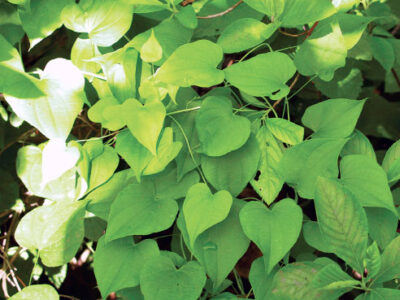Wild yam (Dioscorea villosa) is a versatile herb that might not win any beauty contests. Its rootstocks grow crooked and bear horizontal branches of long, creeping runners with thin reddish-brown stems that grow to a length of over 30 feet.
The plant has winged seed pods and clusters of small, drooping yellow-green flowers that bloom from June to August. The heart-shaped leaves are long and broad with furrowed veins, which run lengthwise from the center top of the heart shape and fan outward. The leaves are usually alternate, but sometimes grow in twos and fours near the base of the plant. The upper surface of the leaf is smooth while the underside is downy.
In medical usage, the herb is best known for chemical components used in the first prescription contraceptive pills. Wild yam root contains diosgenin, which can be converted to synthetic progesterone.
Despite its contraceptive uses, wild yam also is used during pregnancy. Because the herb nourishes the female endocrine system, herbalists believe wild yam can help prevent miscarriage and is one of the best herbs to relieve general pain during pregnancy. Early settlers used the small tubers, as they fell away from the vine, to ease labor pains, colic and leg cramps and to prevent morning sickness and miscarriage.
Wild yam is the basis for many herbal and pharmaceutical remedies and was used widely throughout history in many cultures. The pharmaceutical industry has used yam root as a basis for steroids and cortisone, anti-inflammatory drugs to reduce the swelling caused by rheumatism and hydrocortisone cream to treat eczema. The 16th-century herbalist John Gerard believed it outranked other wild herbs because of its value as a treatment for colic and liver ailments.
Wild yam, which should not be confused with a sweet potato, has been used medicinally in China, Japan and throughout Southeast Asia for at least 2,000 years. It forms part of “The Pill of Eight Ingredients” traditionally prescribed in Chinese medicine to treat hypothyroidism and diabetes. Herbalists also prescribe the herb for exhaustion, lack of appetite, chronic thirst, chronic coughs and wheezing. The herb was popular with the ancient Aztec and Mayan people primarily as a source of food and for pain relief. Colonial doctors learned about this herb from Native Americans and used it as a treatment for rabies, epilepsy and nervous ailments.
Some physicians brewed the flowers into a mild tea for bronchial conditions. Make a decoction by covering the root with boiling water and simmering for half an hour before straining and refrigerating.
The herb has a bitter taste and its most common culinary use is to enhance soups. The root also can be eaten as a boiled vegetable, though it can cause an upset stomach.
This perennial, native to North America, prefers damp woods, swamps and thickets, and grows best in partial shade. Find young tubers in the leaf axils in late summer. Plant them immediately in individual pots and keep them inside until spring. The herb is easy to propagate from root cuttings taken in the late fall or winter. If you plant wild yam near a wall, the leaves will climb gracefully and form a trellis of quiltlike greenery.
Anita B. Stone is a certified master gardener, horticultural therapist and partners an herb business in North Carolina.




